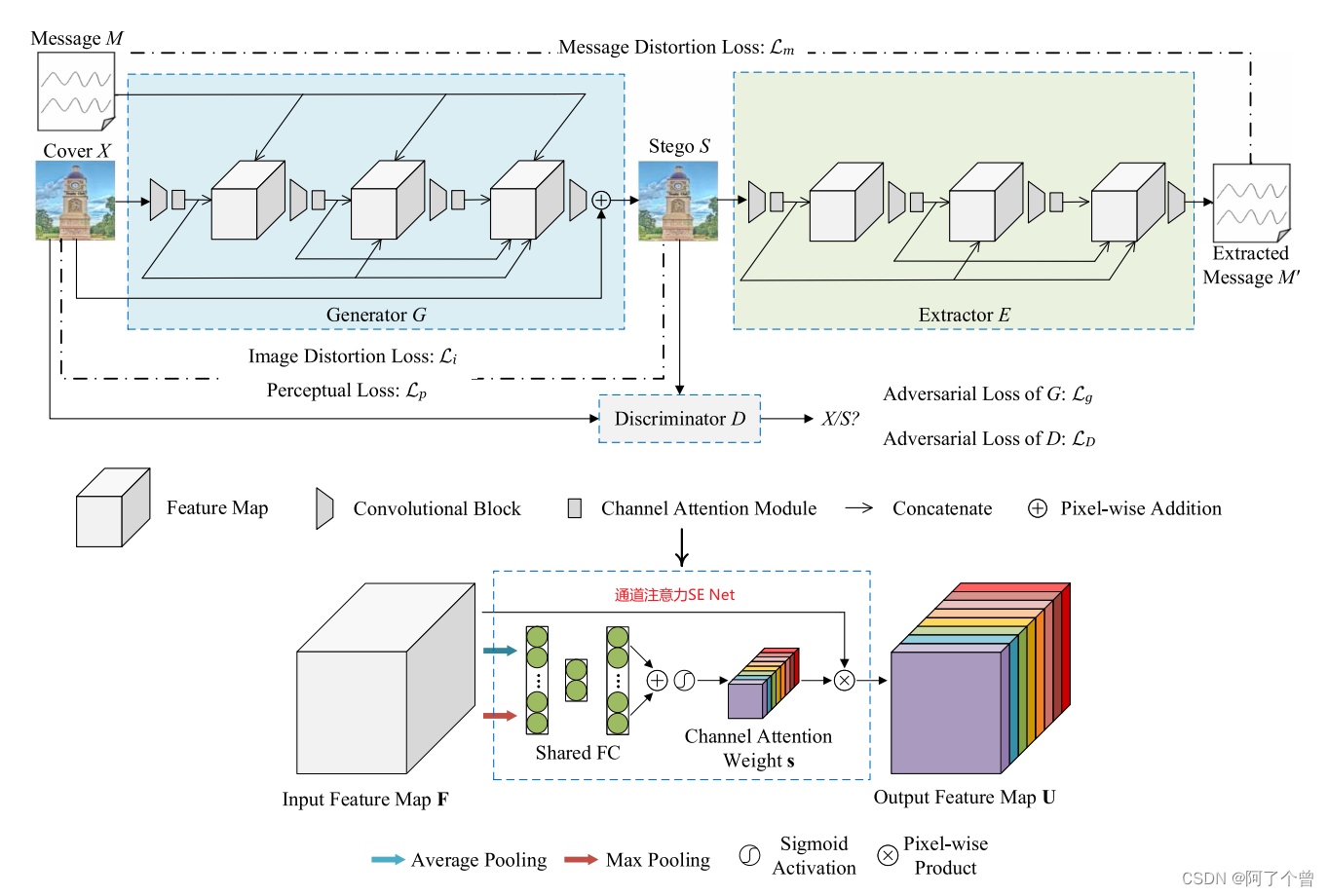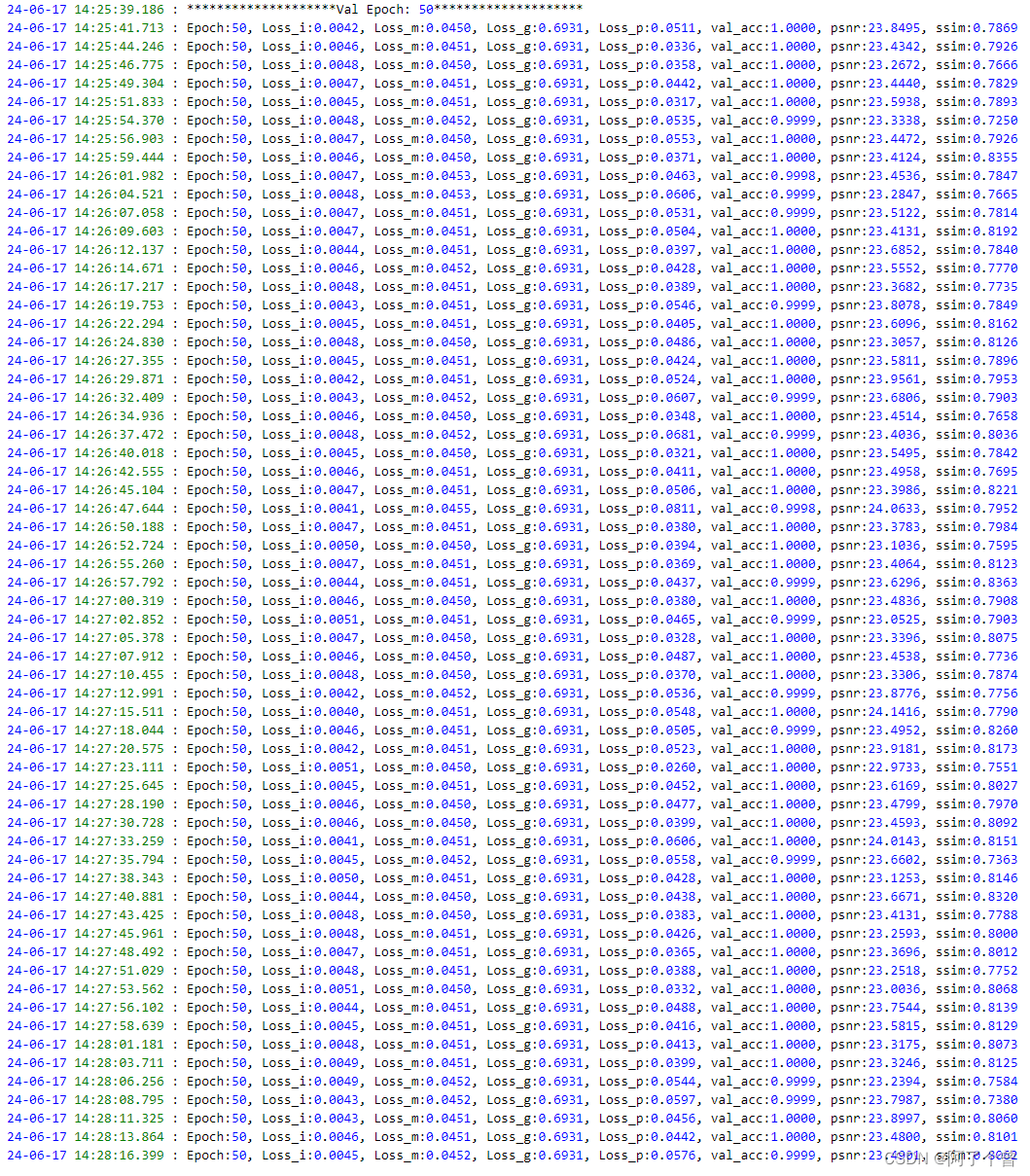Chat-GAN复现
论文地址:https://ieeexplore.ieee.org/document/9667243
代码地址:https://github.com/zengchen233/Chat-GAN (代码我是自己实现的)
训练过程

模型框架

生成器

class ConvBlock(nn.Module):
def __init__(self, in_channels, out_channels):
super(ConvBlock, self).__init__()
self.in_channels = in_channels
self.out_channels = out_channels
self.ConvBlock = nn.Sequential(
nn.Conv2d(in_channels=self.in_channels, out_channels=self.out_channels, kernel_size=3, stride=1, padding=1),
nn.BatchNorm2d(self.out_channels),
nn.LeakyReLU(negative_slope=1e-2, inplace=True)
)
def forward(self, x):
return self.ConvBlock(x)
class NetG(nn.Module):
def __init__(self, img_channels=3, msg_channels=1):
super(NetG, self).__init__()
self.c1 = ConvBlock(in_channels=img_channels, out_channels=32)
self.ca1 = Channel_Attention(channels=32)
self.c2 = ConvBlock(in_channels=32 + msg_channels, out_channels=32)
self.ca2 = Channel_Attention(channels=32)
self.c3 = ConvBlock(in_channels=32 + 32 + msg_channels, out_channels=32)
self.ca3 = Channel_Attention(channels=32)
self.c4 = ConvBlock(in_channels=32 + 32 + 32 + msg_channels, out_channels=img_channels)
def forward(self, x, msg):
origin_x = x
x1 = self.ca1(self.c1(x))
x = torch.cat([x1, msg], dim=1)
x2 = self.ca2(self.c2(x))
x = torch.cat([x, x2], dim=1)
x3 = self.ca3(self.c3(x))
x = torch.cat([x, x3], dim=1)
x4 = self.c4(x)
s = origin_x + x4
return s
通道注意力
class Channel_Attention(nn.Module):
def __init__(self, channels, ratio=16):
super(Channel_Attention, self).__init__()
self.avg_pool = nn.AdaptiveAvgPool2d(output_size=1)
self.max_pool = nn.AdaptiveMaxPool2d(output_size=1)
self.shared_MLP = nn.Sequential(
nn.Linear(in_features=channels, out_features=channels // ratio, bias=False),
nn.ReLU(inplace=True),
nn.Linear(in_features=channels // ratio, out_features=channels, bias=False),
nn.Sigmoid()
)
def forward(self, x):
b, c, _, _ = x.size()
avg_pool = self.avg_pool(x).view(b, c)
max_pool = self.max_pool(x).view(b, c)
avg_out = self.shared_MLP(avg_pool)
max_out = self.shared_MLP(max_pool)
out = (avg_out + max_out).view(b, c, 1, 1)
return out * x
提取器
class NetE(nn.Module):
def __init__(self, img_channels=3):
super(NetE, self).__init__()
self.c1 = ConvBlock(in_channels=img_channels, out_channels=32)
self.ca1 = Channel_Attention(channels=32)
self.c2 = ConvBlock(in_channels=32, out_channels=32)
self.ca2 = Channel_Attention(channels=32)
self.c3 = ConvBlock(in_channels=32 + 32, out_channels=32)
self.ca3 = Channel_Attention(channels=32)
self.c4 = nn.Sequential(
nn.Conv2d(in_channels=32 + 32 + 32, out_channels=1, kernel_size=3, stride=1, padding=1),
nn.BatchNorm2d(1),
nn.Sigmoid()
)
def forward(self, s):
s1 = self.ca1(self.c1(s))
s2 = self.ca2(self.c2(s1))
s = torch.cat([s1, s2], dim=1)
s3 = self.ca3(self.c3(s))
s = torch.cat([s, s3], dim=1)
m = self.c4(s)
return m
判别器
论文中采用的是XuNet,通过修改高通滤波器和卷积的通道数使得XuNet可以判别三通道图像,对这些我不是很懂,只能照猫画虎进行修改:
class ImageProcessing(nn.Module):
"""Computes convolution with KV filter over the input tensor for 3-channel images."""
def __init__(self):
"""Constructor"""
super(ImageProcessing, self).__init__()
# 创建一个3通道的卷积核,每个通道对应一个5x5的索贝尔边缘检测核
self.kv_filter = torch.tensor(
[
[-1.0, 2.0, -2.0, 2.0, -1.0],
[2.0, -6.0, 8.0, -6.0, 2.0],
[-2.0, 8.0, -12.0, 8.0, -2.0],
[2.0, -6.0, 8.0, -6.0, 2.0],
[-1.0, 2.0, -2.0, 2.0, -1.0],
],
dtype=torch.float32
) / 12.0
# print("kv_filter:", self.kv_filter.shape)
self.kv_filter = self.kv_filter.repeat(1, 3, 1, 1).cuda()
# print("kv_filter:",self.kv_filter.shape)
def forward(self, inp):
"""Returns tensor convolved with KV filter for each channel independently"""
# 由于卷积核现在是3通道的,可以直接应用于三通道图像,不需要调整padding或stride
# print("in shape:",inp.shape)
return F.conv2d(inp, self.kv_filter, stride=1, padding=2)
class Xu_ConvBlock(nn.Module):
"""This class returns building block for XuNet class."""
def __init__(
self,
in_channels: int,
out_channels: int,
kernel_size: int,
activation: str = "relu",
abs: str = False,
) -> None:
super(Xu_ConvBlock, self).__init__()
if kernel_size == 5:
self.padding = 2
else:
self.padding = 0
if activation == "tanh":
self.activation = nn.Tanh()
else:
self.activation = nn.ReLU()
self.abs = abs
self.conv = nn.Conv2d(
in_channels,
out_channels,
kernel_size,
stride=1,
padding=self.padding,
bias=False,
)
self.batch_norm = nn.BatchNorm2d(out_channels)
self.pool = nn.AvgPool2d(kernel_size=5, stride=2, padding=2)
def forward(self, inp: Tensor) -> Tensor:
"""Returns conv->batch_norm."""
if self.abs:
return self.pool(
self.activation(self.batch_norm(torch.abs(self.conv(inp))))
)
return self.pool(self.activation(self.batch_norm(self.conv(inp))))
class NetD(nn.Module):
"""Implementation of XuNet."""
"""This class returns XuNet model."""
def __init__(self):
super(NetD, self).__init__()
self.layer1 = Xu_ConvBlock(
1, 8, kernel_size=5, activation="tanh", abs=True
)
self.layer2 = Xu_ConvBlock(8, 16, kernel_size=5, activation="tanh")
self.layer3 = Xu_ConvBlock(16, 32, kernel_size=1)
self.layer4 = Xu_ConvBlock(32, 64, kernel_size=1)
self.layer5 = Xu_ConvBlock(64, 128, kernel_size=1)
self.gap = nn.AdaptiveAvgPool2d(output_size=1)
self.fully_connected = nn.Sequential(
nn.Linear(in_features=128, out_features=128),
nn.Dropout(p=0.4),
nn.ReLU(inplace=True),
nn.Linear(in_features=128, out_features=1),
# nn.LogSoftmax(dim=1),
)
self.init_weights()
def forward(self, image):
"""Returns logit for the given tensor."""
with torch.no_grad():
# print("image shape:",image.shape)
out = ImageProcessing()(image)
# print("out shape:",out.shape)
out = self.layer1(out)
out = self.layer2(out)
out = self.layer3(out)
out = self.layer4(out)
out = self.layer5(out)
out = self.gap(out)
# print(out.shape)
out = out.view(out.size(0), -1)
# print(out.size(0))
out = self.fully_connected(out)
# print(out)
return out
训练结果

这是第50轮的验证结果,不知道为什么Loss_g以及Loss_D的结果都一直不变,可能是这里有问题,有没有dalao能解决一下这里的问题,真的我哭死,搞了一个星期了。
生成图像质量对比:


我的分享就到这里了,接下来的改进就靠大家了,加油兄弟们,奥里给!

























 980
980











 被折叠的 条评论
为什么被折叠?
被折叠的 条评论
为什么被折叠?










